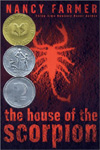The House of the Scorpion

Farmer, Nancy. The House of the Scorpion. New York: Atheneum, 2002. ISBN 0689852223, hc, 380 pp., $17.95.

(This review originally appeared in Mythprint 40:5 (#254) in May 2003.)
Reviewed by Laura Krentz
At nearly six years of age, Matt has spent his short life in a small cottage with only his foster mother, Celia, and the television for company, and occasional visits from a doctor. He longs to be able to play with the children he sees outside his windows. One day, when some children come close enough to talk to him, he breaks a window to escape the locked house, but injures himself by jumping out onto the broken glass. He is rushed to the Big House, where he is kept as a prisoner in a small room and where he is visited and sometimes tormented by the other children.
Matt’s full name is Matteo Alacran. Alacran means “scorpion,” which is where the title The House of the Scorpion comes from. Matt gradually finds out that he is a clone, a genetic copy of El Patron, the 142 year old ruler of the country of Opium, a small strip of land between the United States and what was formerly Mexico but is now called Aztlan. When people try to cross the border from Aztlan to the United States, they are caught by the Farm Patrol and put to work on the opium farms, with chips implanted in their brains so they will be obedient workers, called eejits. Opium sells drugs to countries other than the United States and Aztlan and solves their problems with illegal aliens for them in this world of the future. Clones are normally rendered mentally disabled at birth and are used for spare parts by the rich and powerful. But El Patron ignores the law and enjoys watching Matt grow up and seeing himself as a young man in him. Once he finds out about Matt’s presence in his house, he provides the boy with an education, music lessons, and a kind but gruff bodyguard named Tam Lin. Celia and Tam Lin are the two loving people in his life who teach him about caring and self-preservation. Others in the household mostly scorn him, considering clones to be like animals, but Maria, a United States senator’s daughter, offers him friendship though she refuses to acknowledge how cruel the two-faced Tommy is to Matt.
During the wedding of Maria’s older sister, Emilia, when Matt is 14, El Patron suddenly collapses, and Matt finally realizes that the old man needs his heart to stay alive. Matt must make a daring escape to Aztlan, but is captured there and put into a slave labor camp for orphans, where he makes some new friends and enemies. Though the final chapters seem a bit rushed, Farmer keeps readers on the edge of their seats with exciting plot twists right up to the satisfying conclusion.
The House of the Scorpion is a thought-provoking novel, presenting issues like human cloning, the value of human life, the importance of responsibility and friendship, and the question of how to make social structures work for all the people of a society. Matt is a confused but sympathetic protagonist who has some of the less likable characteristics of El Patron but who also reflects the values he has learned from Celia and Tam Lin. The unusual setting is brought vividly to life with a wealth of detail based on Farmer’s childhood growing up in Yuma, Arizona, near the Mexican border. At 380 pages, the book may be a challenge for younger readers, but it is also rewarding. The book would appeal to science fiction, fantasy, and adventure fans who enjoy a good coming-of-age story. It won a National Book Award and was a Newbery Honor Book.
